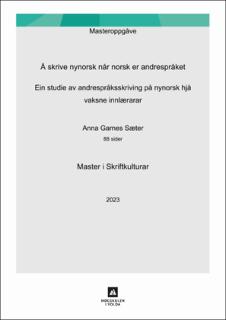| dc.contributor.author | Sæter, Anna Garnes | |
| dc.date.accessioned | 2023-07-05T07:53:27Z | |
| dc.date.available | 2023-07-05T07:53:27Z | |
| dc.date.issued | 2023 | |
| dc.identifier.uri | https://hdl.handle.net/11250/3076001 | |
| dc.description.abstract | Føremålet med denne studien er å starte arbeidet med å etablere eit empirisk grunnlag for å kunne studere norsk andrespråksskriving på nynorsk. Studien freistar å svare på fylgjande overordna forskingsspørsmål: Kva er særskilt i andrespråksskrivinga for innlærarar av norsk som andrespråk som har hatt nynorsk som opplæringsspråk?
Studien er plassert i to ulike forskingsdisiplinar; norsk som andrespråk og forsking på nynorskskriving, og freistar å nytte innsikter frå begge desse fagfelta for å belyse temaet. Materialet som er nytta er 60 tekstar skrivne som svar på Norskprøva, der 30 av desse er skrivne av 15 vaksne innlærarar som har hatt nynorsk som opplæringsspråk, og 30 er skrivne av 15 vaksne innlærarar som har hatt bokmål som opplæringsspråk. Metoden som nyttast er kvantitativ og deskriptiv, med ein eksplorativ inngang til materialet. Avvik i tekstane til dei to gruppene vert analyserte og presenterte. Funna vert diskuterte i lys av forsking på skriving i norsk som andrespråk, forsking på L1-skriving på nynorsk og i lys av det bruksbaserte teoretiske rammeverket CREED (Ellis, 2006) og ein tverrfagleg forståingsmodell utvikla av The Douglas Fir Group (2016).
Resultata viser at mykje er likt i nynorskgruppa og bokmålsgruppa. Samstundes skil dei seg frå kvarandre på visse punkt. Til dømes har nynorskgruppa i mykje mindre grad genussavvik i tekstane sine enn bokmålsgruppa har. L2-innlærarane av nynorsk har visse fellestrekk med L1-innlærarar av nynorsk, men likskapen er ikkje påfallande stor. L2-innlærarane har til dømes ei låg grad av bokmålssamanfallande avvik samanlikna med L1-innlærarane. Studien argumenterer for at nynorsk- og bokmålselevane truleg har ulike språklege kontekstar, og at dette påverkar kva innputt dei møter, som igjen påverkar kva delar av språksystemet dei har vanskar med å tileigne seg. Studien foreslår ei rekke område som bør belysast betre når det gjeld nynorsk i norsk som andrespråk, og peikar på behovet for ein eigen didaktikk for denne innlærargruppa. | en_US |
| dc.description.abstract | English summary
The aim of this study is to initiate a first empirical base when it comes to Norwegian second language writing in Nynorsk. This is to a large extent pioneering work, as no studies have analysed texts from this group of second language learners. The main research question asked is: What characterizes the second language writing of L2 learners of Norwegian, who have received their language training in Nynorsk?
To answer this question, the study uses an exploratory and interdisciplinary approach, and builds on insights from previous studies of Norwegian second language aqcuisition (research which without exception has focused on Bokmål) and studies of L1-users of Nynorsk. The theoretical framework of the study is the usage-based CREED (Ellis, 2006). In addition, it builds on an interdisciplinary model, developed by The Douglas Fir Group (2016), advocating a more ecological approach to the study of second language aqcuisition.
The data is 30 texts written by 15 learners who have received language training in Nynorsk (the Nynorsk group), and 30 texts written by 15 learners who have received language training in Bokmål (the Bokmål group), and the latter is mainly used as a control group. The methods used are quantitative and descriptive, but also explorative (which brings in a qualitative aspect).
The analysis shows that the two groups face similar challenges in their writing, but that they also differ from each other in certain analytic categories. One example is the fact that the Nynorsk group has a much lower number of incorrect use of gender compared to the Bokmål group. Compared to the L1-writers of Nynorsk, the L2-writers have a considerably lower number of mistakes that can be explained by influence from Bokmål.
The study argues that the two groups of learners are experiencing different language contexts and therefore are exposed to different types of input, which again leads to the differences in their mastering of the language. The study proposes that these two groups should be studied in more detail and points out the need for different didactics for these two groups of language learners. | en_US |
| dc.language.iso | nno | en_US |
| dc.publisher | Høgskulen i Volda | en_US |
| dc.subject | nynorskskriving | en_US |
| dc.subject | norsk som andrespråk | en_US |
| dc.subject | nynorsk | en_US |
| dc.subject | opplæringsspråk | en_US |
| dc.subject | L1-skriving | en_US |
| dc.title | Å skrive nynorsk når norsk er andrespråket. Ein studie av andrespråksskriving på nynorsk hjå vaksne innlærarar | en_US |
| dc.type | Master thesis | en_US |
| dc.source.pagenumber | 96 | en_US |
